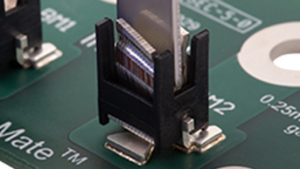Looking To The Stars And Beyond TDK-Lambda configurable power supplies drive Back-end Electronics in Giant Radio Astronomy telescope in Chile
7th October 2010
Source:
Lambda UK

Earlier this year astronomers and engineers successfully positioned and linked three antennas used in a pioneering telescope based at high altitude in the Atacama region of northern Chile. When fully-commissioned with 66 antennas, the giant telescope will be used to observe the universe with pin-point accuracy and help astronomers answer important questions about our cosmic origins. Inside these antennas are two electronic equipment racks, each powered by one of TDK-Lambda’s Vega configurable AC-DC power supplies.
The ALMA (Atacama Large Millimetre/Sub-millimetre Array) antennas use an advanced technology, called the interferometric technique, and are the most sophisticated antennas in the world. The ALMA operations site is based on the Chajnantor plateau in the Andes, which is some 5100 metres above sea-level. Here the Atacama Desert is considered as one of the driest places on Earth and the rarefied air is ideal for ALMA’s observations. In these conditions, however, remote control of the antenna array from a site based at lower altitude some 20km away was necessary so system reliability was critical.
Hank Newton, Integration Electronics Engineer in the Back-end Electronics Group (BEND) of ALMA project, describes his involvement: “Surviving strong winds and temperatures fluctuating between -20°C and +20°C, is quite a challenge even for the two electronic equipment racks inside each antenna. In these racks, we process the signal from the output of the cryogenically cooled antenna front-end and produce a digital output on fibre optic cable.”
To power the racks, the BEND team selected Vega configurable power supplies from TDK-Lambda, one of the world’s leading power supply manufacturers, in preference to developing and testing their own solution as it was more economical and specific outputs requirements could be met. In addition to the Vega’s well-renowned reliability, the ‘smart’ communication capability helped facilitate remote control.
“We use the RS232 port on the Vegas to determine the health of the system, as well as to control the voltage and current settings,” explains Newton. “This remote control capability is another important aspect for the team’s choice in power supply, as each antenna in the array operates fully automatically.”
Having three antennas observing in unison, provides the missing link to correct errors that arise when only two antennas are used, thus paving the way for precise images of the Universe at unprecedented resolution. Ultimately, ALMA will have at least 66 antennas – that’s 132 Vega power supplies from TDK-Lambda - which can be placed on any of about 200 pads, spread over distances of up to 18.5km and operating as a single, giant telescope. When fully-functional, astronomers will study cold clouds of gas and dust, where new stars are being born, and remote galaxies towards the edge of the observable universe.
Hank Newton, Integration Electronics Engineer in the Back-end Electronics Group (BEND) of ALMA project, describes his involvement: “Surviving strong winds and temperatures fluctuating between -20°C and +20°C, is quite a challenge even for the two electronic equipment racks inside each antenna. In these racks, we process the signal from the output of the cryogenically cooled antenna front-end and produce a digital output on fibre optic cable.”
To power the racks, the BEND team selected Vega configurable power supplies from TDK-Lambda, one of the world’s leading power supply manufacturers, in preference to developing and testing their own solution as it was more economical and specific outputs requirements could be met. In addition to the Vega’s well-renowned reliability, the ‘smart’ communication capability helped facilitate remote control.
“We use the RS232 port on the Vegas to determine the health of the system, as well as to control the voltage and current settings,” explains Newton. “This remote control capability is another important aspect for the team’s choice in power supply, as each antenna in the array operates fully automatically.”
Having three antennas observing in unison, provides the missing link to correct errors that arise when only two antennas are used, thus paving the way for precise images of the Universe at unprecedented resolution. Ultimately, ALMA will have at least 66 antennas – that’s 132 Vega power supplies from TDK-Lambda - which can be placed on any of about 200 pads, spread over distances of up to 18.5km and operating as a single, giant telescope. When fully-functional, astronomers will study cold clouds of gas and dust, where new stars are being born, and remote galaxies towards the edge of the observable universe.
Similar articles
More from Lambda UK
- 100W Low Profile PCB-mountable Power Supplies 25th November 2010
- 100W and 150W PCB power supplies – ZWS-BAF series from TDK-Lambda 16th November 2010
- TDK-Lambda introduces 40-65W AC-DC medical power supplies 12th November 2010
- EFE400M digitally controlled medical power supplies from TDK-Lambda 2nd November 2010












Write a comment
No comments